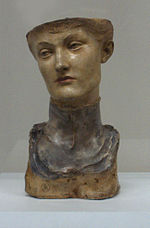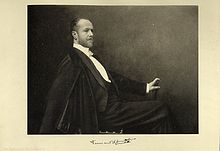Fernand Khnopff
Fernand-Edmond-Jean-Marie Khnopff (born September 12, 1858 in Grembergen near Dendermonde , Flanders , † November 12, 1921 in Brussels ) was a Belgian painter, graphic artist , sculptor , photographer and art writer. Alongside James Ensor, he is considered to be the main representative of Belgian symbolism .
Life



Khnopff came from a German-Austrian family who had come to the southern Netherlands around 1600 with Albrecht VII of Austria from the area around Vienna . He grew up in Bruges . After his parents moved to Brussels, he initially studied law here at the insistence of his father, but at the age of twenty he switched to the Brussels Art Academy, where he worked under his teachers Xavier Mellery (1845–1921) and Jean-François Portaels (1818–1895 ) began his painting career with naturalistic landscapes and portraits. On a trip to Paris in 1877 he was influenced by Eugène Delacroix and met the Pre-Raphaelites in England . He was in contact with Maurice Maeterlinck and Émile Verhaeren , who wrote a book about him.
In 1878 he began studying in Paris with Jules-Joseph Lefebvre and Gustave Boulanger at the Académie Julian . At the Paris World Exhibition in 1878 (Exposition Universelle de Paris) , the works of the English Pre-Raphaelites around Dante Gabriel Rossetti and Edward Burne-Jones with their mystical themes made a great impression on him. He became acquainted with the painter Gustave Moreau and subsequently devoted himself increasingly to symbolism. In 1883 he was one of the founders of the Société des Vingt together with James Ensor .
Khnopff exhibited for the first time at the Paris Salon in 1884 and now became the favored painter of bourgeois society. Between 1884 and 1890 he painted 34 portraits, including Portrait Jeanne Kéfer (Getty) and Portrait Marie Monnom (Musée d'Orsay). However, his preferred model always remained his own sister Marguerite, with whom he lived in a richly furnished house that he designed himself. "The touch of incest, which seems to hover over all of the art of the late 19th century, is also visible in the life and work of Khnopff."
In 1889 Khnopff had his first contacts in Great Britain , where he lived and exhibited regularly. British artists like William Holman Hunt , George Frederic Watts , Dante Gabriel Rossetti, Ford Madox Brown and Edward Burne-Jones became his friends. In 1892 he exhibited at the Paris Salon de la Rose-Croix . From 1895 Khnopff worked as a correspondent for the art magazine The Studio . Until the outbreak of the First World War in 1914, Khnopff was responsible for the “Studio-Talks-Brussels” column, in which he reported on artistic developments in Belgium and continental Europe.
In March 1898 Khnopff had a selection of 21 works at the first exhibition of the Vienna Secession . His work was enthusiastically received in Vienna. His works exhibited there had a great influence on the oeuvre of the Austrian painter Gustav Klimt .
Khnopff had a passion for theater and opera. In 1903, for example, he designed the stage sets for Georges Rodenbach's play Le Mirage at the Deutsches Theater Berlin , which was performed under the direction of Max Reinhardt . In 1904 he designed decorative panels for the music hall of the Palais Stoclet for the banker Adolphe Stoclet . Here Khnopff again met prominent artists from the Vienna Secession such as the architect of the Stoclet Palace, Josef Hoffmann , and Gustav Klimt, who had designed a mosaic for the dining room.
Fernand Khnopff died at the age of 63 and was buried in the Laeken / Laken cemetery in Brussels.
power
His choice of colors consisted of dark, slightly morbid shades with which he captured mystical fantasies on canvas . With his style, he mainly influenced German symbolism, for example in the form of Franz von Stuck , as well as Art Nouveau . Most of the women in Khnopff's pictures appear in the form of chimeras , harpies and sphinxes . These include, for example, the Sleeping Harpy , created around 1885 , The Solitude of 1894 and The Art or The Caresses (1896). He also created portraits and landscapes as well as illustrations for works by other artists of his time.
Works (selection)


- 1883: The game warden , Städelsches Kunstinstitut
- around 1885: Sleeping harpy
- 1887: Marie Monnom , 49.5 × 50 cm, Paris, Musée d'Orsay
- 1891: I lock my door upon myself ( I lock myself into myself ), oil on canvas, 72.7 × 141 cm, Munich , Neue Pinakothek (inv. No. 7921)
- 1894: Still water - The pond of Menil , oil on canvas, 53.5 × 114.5 cm, Vienna , Belvedere (inv.no.7753),
- 1894: The loneliness
- 1896: Half figure of a nymph ("Vivien") plaster, 99 cm, Vienna, Belvedere (inv. No. 4431)
- 1896: The Art or The Caresses , oil on canvas, 50 × 150 cm, Brussels , Musées Royaux des Beaux-Arts
- around 1904: L'Encens (incense), oil on wood, Neuss , Clemens-Sels-Museum
- around 1904: A Bruge. Un Portail (Bruges. The Church of Notre Dame), oil on canvas, Neuss, Clemens-Sels-Museum
literature
- Fernand Khnopff. Exhibition catalog compiled by Frederik Leen and others. Hatje Cantz, Ostfildern 2004, ISBN 978-3-7757-1435-8 .
- Fernand Khnopff . In: Hans Vollmer (Hrsg.): General lexicon of fine artists from antiquity to the present . Founded by Ulrich Thieme and Felix Becker . tape 20 : Kaufmann – Knilling . EA Seemann, Leipzig 1927, p. 246-247 .
- Film, documentary, Fernand Khnopff: Caresses. In: 100 (0) masterpieces , 10 min. (October 14, 2012, 3sat , 9.05–9.15)
Web links
- Literature by and about Fernand Khnopff in the catalog of the German National Library
- Fernand Khnopff at artfacts.net
- Works by Fernand Khnopff at Zeno.org .
- Works by Fernand Khnopff In: Digitales Belvedere
Individual evidence
- ^ Luigi Carluccio: The sacred and profane in Symbolist art. Art Gallery of Ontario, Toronto, November 1 to 26, 1969, p. XLV.
- ↑ Jane Turner: The Dictionary of Art. Grove's Dictionaries, 1996, Volume 18, p. 23, ISBN 1-884446-00-0 .
- ^ Biography Neue Pinakothek, Munich ( Memento from March 26, 2016 in the Internet Archive )
- ^ Jörg Krichbaum, Rein A. Zondergeld: Lexicon of Fantastic Painting. DuMont, 2nd edition, 1890, ISBN 3-7701-0908-2 , p. 142.
- ↑ Laurent Busine: To Sir Edward Burne-Jones from Fernand Khnopff in: Fernand Khnopff 1858-1921. Exhibition catalog. Brussels, Salzburg, Boston, 2003-2004, pp. 45-52.
- ↑ a b Fernand Khnopff et ses reports avec la Secession Viennoise. Exhibition catalog Brussels, 1987.
- ↑ knerger.de: Fernand Khnopff's grave
| personal data | |
|---|---|
| SURNAME | Khnopff, Fernand |
| ALTERNATIVE NAMES | Khnopff, Fernand-Edmond-Jean-Marie (full name) |
| BRIEF DESCRIPTION | Belgian painter, printmaker, sculptor and art writer |
| DATE OF BIRTH | September 12, 1858 |
| PLACE OF BIRTH | Grembergen |
| DATE OF DEATH | November 12, 1921 |
| Place of death | Brussels |


